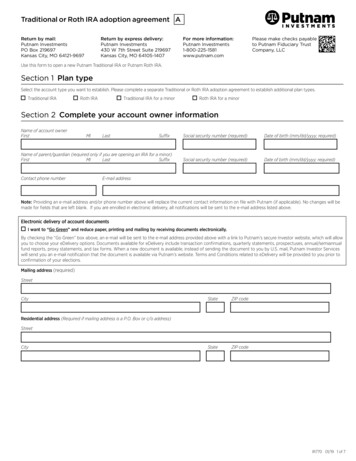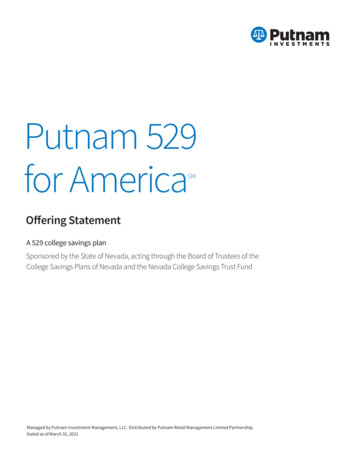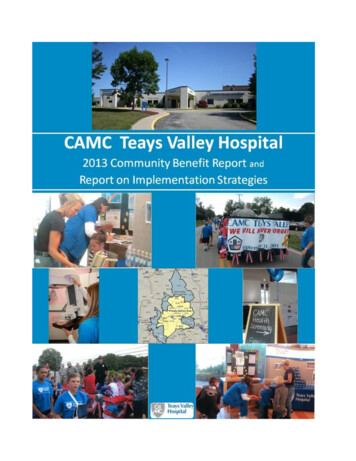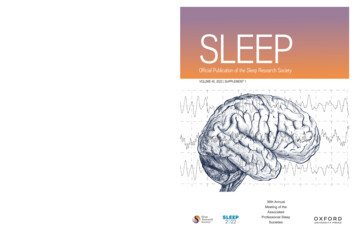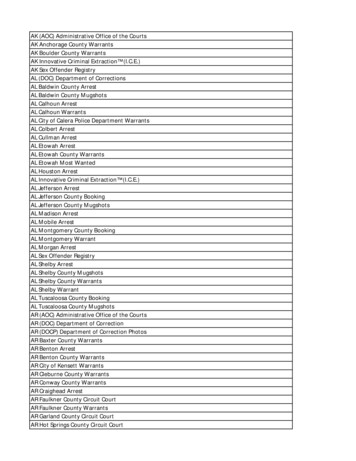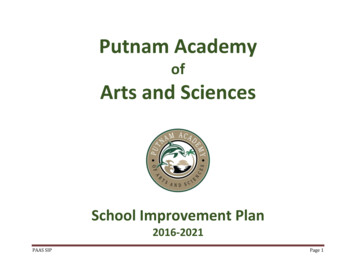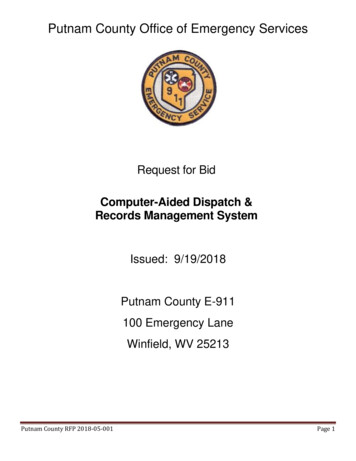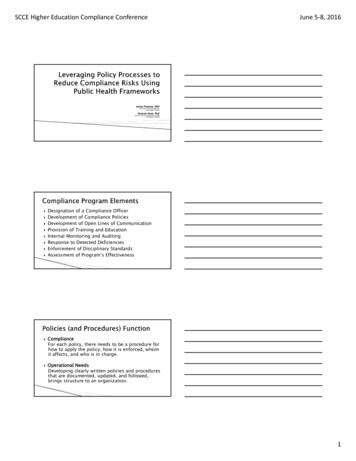
Transcription
SCCE Higher Education Compliance ConferenceJune 5‐8, 2016Janice Putnam, PhDUniversity of Central Missouriputnam@ucmo.eduVictoria Steel, PhDLaramie County Community Collegevsteel@lccc.wy.edu Designation of a Compliance OfficerDevelopment of Compliance PoliciesDevelopment of Open Lines of CommunicationProvision of Training and EducationInternal Monitoring and AuditingResponse to Detected DeficienciesEnforcement of Disciplinary StandardsAssessment of Program’s EffectivenessComplianceFor each policy, there needs to be a procedure forhow to apply the policy, how it is enforced, whomit affects, and who is in charge.Operational NeedsDeveloping clearly written policies and proceduresthat are documented, updated, and followed,brings structure to an organization.1
SCCE Higher Education Compliance Conference June 5‐8, 2016Managing RisksPolicies and procedures serve as a internal controlmethod ensuring consistency across theorganization.Continuous ImprovementConsistently applied policies and procedures assistin the day-to-day decision-making processes.Examine ethical andtactical policyprocesses identifiedin PHLeverage theseprocesses toimprove governance,risk managementand compliance inHE5 Complex, highly regulated systemsExperts generate successful outcomes in theirtarget populationLag behind for-profit in paper.pdf62
SCCE Higher Education Compliance Conference June 5‐8, 2016Similar service ethicPatient/student focusIncreased efficiency impacts more lives (notnecessarily profit er.pdf7The terms of reference of the Council are: to identify and define ethical questions raised byrecent advances in biological and medical researchin order to respond to, and to anticipate, publicconcern;www.nuffieldbioethics.org8The terms of reference of the Council are: to make arrangements for examining and reportingon such questions with a view to promoting publicunderstanding and discussion; this may lead,where needed, to the formulation of new guidelinesby the appropriate regulatory or other body;www.nuffieldbioethics.org93
SCCE Higher Education Compliance ConferenceJune 5‐8, 2016The terms of reference of the Council are: in the light of the outcome of its work, to publishreports; and to make representations, as theCouncil may judge appropriate.The Nuffield Council on Bioethics is funded jointly bythe Medical Research Council, the NuffieldFoundation and the Wellcome Trust.10 RiskPrecaution and ProportionBehaviour ChangeIntervention LaddersStakeholders and Policy MakingEconomicsChoiceVulnerable Groups, Inequality, and Targeted InterventionsEvidence“Part of the answer to the question of whether or notthe state should intervene to protect and promotehealth depends on the nature and extent of the riskinvolved, including the degree to which it ispotentially under the control of the individual.”www.nuffieldbioethics.org4
SCCE Higher Education Compliance Conference Statistical/Technical Approach Politics and Culture Perceptions and Judgements Decision TheoryNo. SubjectAnswer these questions for program activities:June 5‐8, 2016ScoreNA123451. Newness of program2. Expected appropriation for the program inimmediate year following3. Nature of the program4. Recent changes in resource levels5. Impact or sensitivity of the program onpersons or organizations external to theagencyDHS/OFCO/FAPO Version 1.05
SCCE Higher Education Compliance ConferenceJune 5‐8, 2016“In any policy decision, it is furthermore important toconsider the seriousness of the problem and theurgency with which it should be addressed issuesthat pose severe and urgent threats to the health ofmany people are rightly prioritised over those thatare only ‘possible threats’, affect health in arelatively minor way or involve fewer people.”www.nuffieldbioethics.orgPolicy Response Test Balance: aim justifies means Suitability: means justifies end Necessity: choice among meanswww.nuffieldbioethics.org6
SCCE Higher Education Compliance ConferenceJune 5‐8, 2016“The success of public health interventions oftendepends on more than the cooperation of membersof the population. Many different stakeholdergroups, including health professionals, the corporatesector, non-governmental organizations (NGOs),institutions of civil society and the media, can have acrucial role to play.”www.nuffieldbioethics.org“All the various strands of opinion and its translationinto policy is a matter that politicians and theiradvisors must consider [and] can have personal orprofessional conflicts of interest ”www.nuffieldbioethics.org7
SCCE Higher Education Compliance Conference Funders Accreditors Auditors Donors Institutional Finance and Administration Compliance Offices/FunctionsJune 5‐8, 2016 Program operations: Management, program staff, partners, funding agencies, andcoalition members. Those served or affected: Patients or clients, advocacy groups, community members,and elected officials. Intended users: Decision-makers, such as partners, funding agencies,coalition members, and the general public or taxpayers.http://www.cdc.gov/eval/guide/step1/23 Valuable stakeholdersInspires and informs about policy and practice activitiesCreates space for voices to be heardFosters social awareness and changeFacilitates understandingContributes to evidence based policyPrevents hindering of progressHovland, I. (2007). Successful Communication: A toolkit for researchers and civil society organizations,RAPID Toolkit, London: ODI assets/publicationsopinion-files/192.pdf)248
SCCE Higher Education Compliance ConferenceJune 5‐8, 2016Mapping: Assesses stakeholdersPrimarySecondaryKeyAnalysis: Importance and interestPowerInterest Hovland, I. (2007). Successful Communication: A toolkit for researchers and civil society organizations, RAPID Toolkit, London: u, S. (2008). What is Stakeholder Analysis? )Glassman, T., Reindl, D., Whewell, A. (2011) Strategies for implementing a tobacco-free campus policy. Journal of American College Health. 59(8) 764-768.25 AutonomyChallenges: UnavailableIngrained habitsPredetermination by industry & mediaAbundance of oads/2014/07/Public-health-ethical-issues.pdf26 Change the external circumstances makinghealthy choices easier to makeImprove individual’s capacity to make df279
SCCE Higher Education Compliance Conference June 5‐8, 2016Written informationWebsitesComputer based information and virtual supportTraining for professionals in communicationskillsCoaching and question promptsDecision aides for patientsSelf management education sionmaking/WhereArePatientsinDecisionMaking.pdf28 Equity: The fair distribution of benefits andburdens.Inequities - differences in health unnecessary avoidable considered unfair and s/WHO CDS EPRGIP 2007 2c.pdf29 Socio-economic statusGenderRace or ethnicityMigration historyDegree of ues.pdf3010
SCCE Higher Education Compliance Conference June 5‐8, 2016Advantaged groups show longer lifeexpectancy, better health and more healthpromoting behaviorsEvidence links low socio-economic status(occupation, education, income or assets) topoorer ds/2014/07/Public-health-ethical-issues.pdf31 Targeting disadvantaged groups Targeting at risk groups Universal uploads/2014/07/Public-health-ethical-issues.pdf32 Engage and empower community leadersAssess needs and readinessRelevant, current local dataSources of influence among groupsCulturally oriented education and economicsAssistance for local programsIdentify contributing factorsTailored messagesMissouri Comprehensive Tobacco ControlStrategic Plan (2016).3311
SCCE Higher Education Compliance Conference June 5‐8, 2016health systems in all countries struggle toeffectively implement evidence-informedinterventions.“In low- and middle-income countries oftenthere is no process to ensure scientificevidence is accessible and translated within thecontext to the program managers and policymakers who need g evidence/en/34 Most policy makers reportedly “were nottrained to distinguish between good and baddata, and were, therefore, prone to the influence ofmisused “facts” often presented by specialinterest groups.Brownson, R. Chriqui, J. & Stamatakis, K. (2009). Understanding Evidence-Based Public HealthPolicy. Am J Public Health. September; 99(9): 1576–1583.35 Quantitative Evidence Hierarchy Qualitative Evidence Systematic reviewsPeer-reviewed journal articlesPublic health surveillance systemsIndividual programs and policies Observations Interviews Focus groupsBrownson, R. Chriqui, J. & Stamatakis, K. (2009). Understanding Evidence-BasedPublic Health Policy. Am J Public Health. September; 99(9): 1576–1583.3612
SCCE Higher Education Compliance Conference Electronic informationTrust issuesSources of informationState to state comparisons Surveys of policymakers: priorities, attitudes towards lobbying efforts, obstacles,attitudes and voting intentionsBrownson, R. Chriqui, J. & Stamatakis, K. (2009). Understanding Evidence-BasedPublic Health Policy. Am J Public Health. September; 99(9): 1576–1583. oo 37Process – enhances policy adoptionContent – identifies effective elementsOutcome – documents policy impactPolicies evolve as they diffuseFraming is importantPartnerships between researchers, practitionersand policymakers enhance these processesBrownson, R. Chriqui, J. & Stamatakis, K. (2009). Understanding Evidence-Based PublicHealth Policy. Am J Public Health. September; 99(9): 1576–1583. June 5‐8, 201638Economic arguments varydifferent ethical frameworksdifferent assumptions about health behavior.Tradeoffs affect policy Employment and health Employment and design of 13
SCCE Higher Education Compliance Conference June 5‐8, 2016Reducing healthcare cost to systemFewer work absencesNo health related loss of skillsOther values: quality and quantity of life, publicgood, reducing health 0 Big stickAim – to ensure economic efficiency andmake best use of scarce resourcesMay put burden on those with variations indisposable incomehealth Personal behaviors can have a significant effect onhealth, and therefore a common theme in publichealth policy is behavior change.”Public Health Behavior Change Theories Social Cognitive Theory Theory of Planned Behavior The Trans-Theoretical (or Stages of Change) Model14
SCCE Higher Education Compliance ConferenceJune 5‐8, 2016“A more intrusive policy initiative is acceptable onlyif it is clear that it will produce the desired effect andthat this can be weighed against the loss of libertythat will result.”Considerations Individual Freedom and Responsibility Economic Costs and Benefits Societal Costs and Benefits Do nothing or simply monitor the current situation; Provide information; Enable choice; Guide choices through changing the default policy;www.nuffieldbioethics.org Guide choices through incentives; Guide choice through disincentives; Restrict choice; Eliminate choice.www.nuffieldbioethics.org15
SCCE Higher Education Compliance Conference June 5‐8, 2016Public Health and Higher Education have manycommonalitiesNuffield Council on Bioethics has nine Public Healthpolicy process considerationsThese considerations can be useful in designing HigherEducation compliance and risk reduction policydevelopment processesThese considerations can provide structure forevaluating ethical and evidence elements whenassessing compliance policies4616
Janice Putnam, PhD University ofCentralMissouri putnam@ucmo.edu Victoria Steel, PhD LaramieCountyCommunityCollege vsteel@lccc.wy.edu Designation of a Compliance Officer Development of Compliance Policies Development of Open Lines of Communication Provision of Training and Education Internal Monitoring and Auditing


